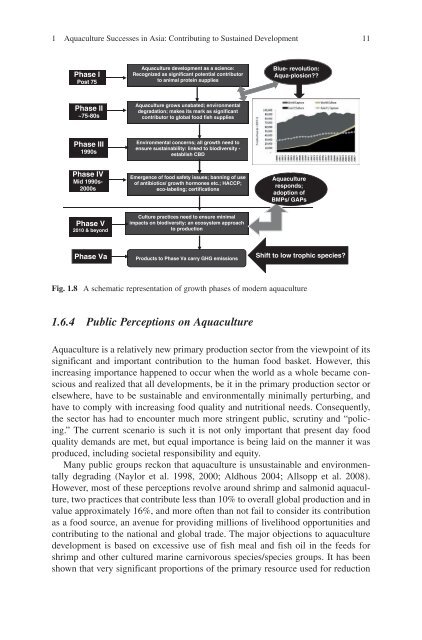Success Stories In Asian Aquaculture - Library - Network of ...
Success Stories In Asian Aquaculture - Library - Network of ...
Success Stories In Asian Aquaculture - Library - Network of ...
- No tags were found...
Create successful ePaper yourself
Turn your PDF publications into a flip-book with our unique Google optimized e-Paper software.
1 <strong>Aquaculture</strong> <strong>Success</strong>es in Asia: Contributing to Sustained Development11Phase IPost 75<strong>Aquaculture</strong> development as a science:Recognized as significant potential contributorto animal protein suppliesBlue- revolution:Aqua-plosion??Phase II~75-80s<strong>Aquaculture</strong> grows unabated; environmentaldegradation; makes its mark as significantcontributor to global food fish suppliesPhase III1990sEnvironmental concerns; all growth need toensure sustainability: linked to biodiversity -establish CBDPhase IVMid 1990s-2000sPhase V2010 & beyondEmergence <strong>of</strong> food safety issues; banning <strong>of</strong> use<strong>of</strong> antibiotics/ growth hormones etc.; HACCP;eco-labeling; certificationsCulture practices need to ensure minimalimpacts on biodiversity; an ecosystem approachto production<strong>Aquaculture</strong>responds;adoption <strong>of</strong>BMPs/ GAPsPhase VaProducts to Phase Va carry GHG emissionsShift to low trophic species?Fig. 1.8 A schematic representation <strong>of</strong> growth phases <strong>of</strong> modern aquaculture1.6.4 Public Perceptions on <strong>Aquaculture</strong><strong>Aquaculture</strong> is a relatively new primary production sector from the viewpoint <strong>of</strong> itssignificant and important contribution to the human food basket. However, thisincreasing importance happened to occur when the world as a whole became consciousand realized that all developments, be it in the primary production sector orelsewhere, have to be sustainable and environmentally minimally perturbing, andhave to comply with increasing food quality and nutritional needs. Consequently,the sector has had to encounter much more stringent public, scrutiny and “policing.”The current scenario is such it is not only important that present day foodquality demands are met, but equal importance is being laid on the manner it wasproduced, including societal responsibility and equity.Many public groups reckon that aquaculture is unsustainable and environmentallydegrading (Naylor et al. 1998, 2000 ; Aldhous 2004 ; Allsopp et al. 2008) .However, most <strong>of</strong> these perceptions revolve around shrimp and salmonid aquaculture,two practices that contribute less than 10% to overall global production and invalue approximately 16%, and more <strong>of</strong>ten than not fail to consider its contributionas a food source, an avenue for providing millions <strong>of</strong> livelihood opportunities andcontributing to the national and global trade. The major objections to aquaculturedevelopment is based on excessive use <strong>of</strong> fish meal and fish oil in the feeds forshrimp and other cultured marine carnivorous species/species groups. It has beenshown that very significant proportions <strong>of</strong> the primary resource used for reduction
















